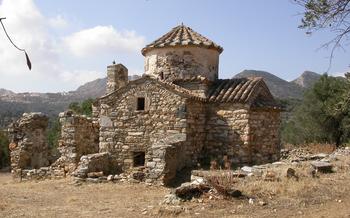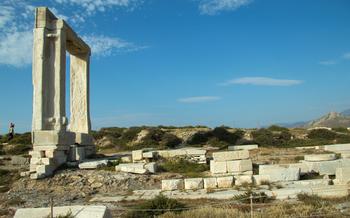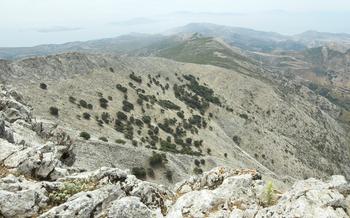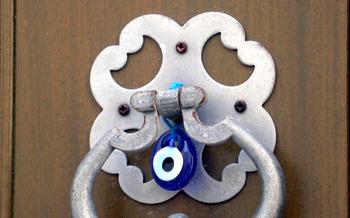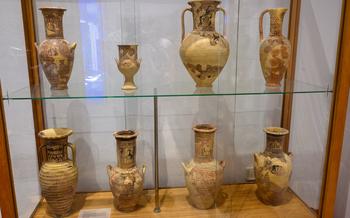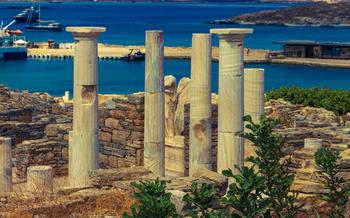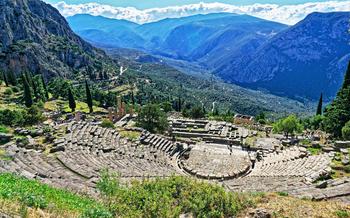
Archaeological Museum of Naxos
- Historical Background
- Architectural Features
- Museum Collections
- Cycladic Art
- Marble Sculptures
- Pottery and Ceramics
- Bronze Artifacts
- Numismatic Collection
- Interactive Exhibits
- Temporary Exhibitions
- Museum Shop
- Insider Tip: Unveiling the Secrets of the Archaeological Museum
Historical Background
Naxos, the largest island in the Cyclades group, boasts a rich and storied history that dates back to the Neolithic period. The Archaeological Museum of Naxos stands as a testament to this rich past, housing a diverse collection of artifacts that offer a glimpse into the island's ancient civilization, from the Cycladic era to the Roman period.
The museum's collection is of great significance as it sheds light on the development of Naxian culture and its interactions with other civilizations in the Aegean region. It provides valuable insights into the island's artistic traditions, religious beliefs, economic activities, and daily life from prehistoric times to the dawn of Christianity.
Architectural Features
The Archaeological Museum of Naxos is housed in a stunning neoclassical building that was constructed in the late 19th century. The building's design was inspired by ancient Greek architecture, featuring symmetrical lines, Doric columns, and a grand entrance portico. The exterior of the museum is adorned with intricate carvings and sculptures, depicting mythological scenes and historical events.
The interior of the museum is equally impressive, with a spacious and well-lit layout that showcases the artifacts in a visually appealing manner. The museum's galleries are adorned with marble floors, vaulted ceilings, and large windows that allow natural light to flood in, illuminating the ancient treasures on display.
Museum Collections
The Archaeological Museum of Naxos houses a diverse collection of artifacts that span the island's rich history from the Neolithic period to the Roman era. The exhibits provide a glimpse into the daily lives, artistic traditions, and religious practices of the ancient Naxians.
Among the highlights of the collection are the Cycladic figurines, dating from the Early Bronze Age. These enigmatic marble sculptures, often depicting stylized human forms, offer a unique insight into the artistic expressions of the Cycladic civilization.
The museum also boasts an impressive collection of marble sculptures from the Archaic and Classical periods. These include kouroi and korai, which are life-size statues of young men and women that were often used as funerary monuments or as votive offerings to the gods.
Another highlight of the museum is its collection of ancient jewelry. The exquisite craftsmanship of these pieces, made from gold, silver, and bronze, showcases the skill and artistry of ancient Greek goldsmiths. The jewelry includes necklaces, earrings, bracelets, and rings, many of which feature intricate designs and precious gemstones.
Cycladic Art
The Archaeological Museum of Naxos houses a rich collection of Cycladic art, providing a glimpse into the ancient civilization that thrived in the Aegean Sea during the Bronze Age (3000-2000 BC). Cycladic art is characterized by its distinctive figurines, which are crafted from white marble and depict stylized human forms. These figurines are believed to have had both ritualistic and funerary functions, serving as offerings to the gods or as representations of the deceased.
Among the highlights of the museum's Cycladic collection is the famous "Kouros of Naxos," a life-size marble statue from the Early Cycladic period (2800-2300 BC). The statue depicts a nude male figure with a serene expression and elongated limbs, representing the ideals of beauty and strength in Cycladic culture. Other notable artifacts include pottery vessels, marble tools, and jewelry, which provide insights into the daily life and craftsmanship of the Cycladic people.
The Cycladic collection at the Archaeological Museum of Naxos offers a unique opportunity to explore the origins of Greek art and culture. These fascinating artifacts provide a glimpse into the beliefs, rituals, and artistic traditions of one of the earliest civilizations in the Aegean region.
Marble Sculptures
Naxos is renowned for its exceptional marble, and the Archaeological Museum proudly showcases a remarkable collection of marble sculptures that exemplify the island's rich artistic heritage. These sculptures span various periods, from the Archaic to the Classical era, and offer a glimpse into the extraordinary skill and artistry of Naxian sculptors.
Among the highlights of the collection is the colossal kouros, an unfinished statue of a young man dating back to the 6th century BC. Standing over 10 feet tall, this impressive sculpture reveals the mastery of Naxian sculptors in working with large-scale marble. Its unfinished state provides a fascinating insight into the techniques and processes involved in ancient Greek sculpture.
Another notable piece is the Gorgon Medusa, a finely carved head of the mythical creature with snakes for hair. The intricate details and expressive features of the Medusa reflect the exceptional craftsmanship of Naxian artists. This sculpture is believed to have adorned a temple dedicated to Athena, the goddess of wisdom and warfare, further emphasizing the significance of Naxos in ancient Greek mythology.
The museum also houses a collection of smaller marble sculptures, including statues of deities, animals, and everyday objects. These works provide a glimpse into the daily life and religious practices of the ancient Naxians. The sheer variety and quality of these sculptures attest to the thriving artistic community that existed on the island during antiquity.
Pottery and Ceramics
The Archaeological Museum of Naxos houses a captivating collection of pottery and ceramics that spans different eras of Naxian history, from the Neolithic period to the Hellenistic period. These exquisite artifacts provide valuable insights into the evolution of pottery styles, decorative motifs, and techniques used by Naxian artisans.
The Neolithic period, dating back to the 7th millennium BC, is represented by impressive pottery characterized by simple forms and incised decorations. These early vessels served both utilitarian and ritualistic purposes, showcasing the ingenuity of the prehistoric inhabitants of Naxos.
As the centuries progressed, the pottery styles gradually evolved, reflecting the artistic influences of neighboring civilizations. During the Bronze Age (3rd millennium BC), the use of the potter's wheel became widespread, allowing for the creation of more intricate forms and sophisticated decorative patterns.
The Geometric period (8th century BC) witnessed the emergence of geometric motifs, such as circles, triangles, and zigzags, which adorned the surfaces of pottery. These patterns held both aesthetic and symbolic significance, often representing natural elements or religious beliefs.
The Archaic period (7th-6th centuries BC) marked a period of artistic flourishing in Naxos. Potters began experimenting with new forms and techniques, creating elegant vessels with black-figure and red-figure decorations. These intricate paintings depicted mythological scenes, historical events, and everyday life, providing a glimpse into the vibrant culture of ancient Naxos.
The Classical period (5th-4th centuries BC) saw the continuation of the red-figure tradition, with potters achieving remarkable levels of detail and realism in their depictions. During this time, the production of large storage jars known as pithoi became prevalent, serving practical purposes in the storage of wine, oil, and other commodities.
The Hellenistic period (3rd-1st centuries BC) witnessed the influence of Hellenistic art and culture, resulting in the creation of pottery with a wider range of forms and decorative styles. This period also saw the introduction of new techniques, such as glazing and molding, which further enhanced the beauty and functionality of Naxian pottery.
Exploring the pottery and ceramic collection at the Archaeological Museum of Naxos is a journey through time, allowing visitors to witness the evolution of artistic expression and craftsmanship that has shaped the rich cultural heritage of this captivating island.
Bronze Artifacts
In the realm of metallurgy, the ancient Greeks demonstrated exceptional skill in crafting bronze objects. The Archaeological Museum of Naxos proudly showcases a remarkable collection of bronze artifacts that encapsulate the mastery and versatility of this ancient craft. From intricately detailed figurines to functional tools and weapons, these bronze objects offer a glimpse into the daily lives, beliefs, and technological prowess of the Naxians.
Among the highlights of the collection is a series of bronze statuettes depicting various deities and mythological figures. These finely crafted sculptures, with their expressive features and graceful postures, provide valuable insights into the religious and artistic traditions of ancient Naxos. Visitors can admire the exquisite rendering of the god Apollo, with his flowing robes and radiant countenance, or marvel at the intricate details of the goddess Artemis, depicted as a huntress with her faithful hounds.
The museum also houses an impressive array of bronze tools and weapons, shedding light on the practical aspects of life in ancient Naxos. From sturdy agricultural implements to finely crafted weapons, these objects speak to the ingenuity and resourcefulness of the Naxian people. Visitors can examine bronze sickles, used to harvest the island's bountiful crops, or admire the craftsmanship of bronze swords and spearheads, symbols of the Naxians' military prowess.
These bronze artifacts, with their artistic and functional significance, offer a tangible connection to the vibrant past of Naxos. They invite visitors to appreciate the extraordinary skills and creativity of the ancient Greeks, who transformed this versatile metal into objects of beauty, utility, and symbolic power.
Numismatic Collection
The Archaeological Museum of Naxos boasts an impressive numismatic collection, shedding light on the monetary history of the island and ancient Greece as a whole. Coins, minted from various metals such as silver, bronze, and gold, provide valuable insights into the economic and political landscape of different periods.
A highlight of the collection is a rare silver tetradrachm from the 5th century BC, featuring the head of Dionysus on one side and a satyr on the other. This coin showcases the exquisite craftsmanship and artistry of Naxian engravers, capturing the essence of Greek mythology and religious beliefs.
Visitors can also admire a series of bronze coins from the Hellenistic period, bearing the effigies of rulers like Alexander the Great and his successors. These coins not only served as a means of exchange but also functioned as propaganda tools, reinforcing the authority and legitimacy of the ruling dynasties.
The numismatic collection at the Archaeological Museum of Naxos offers a compelling narrative of Naxos's economic and political development, providing a tangible link to the island's rich past.
Interactive Exhibits
The Archaeological Museum of Naxos is not just a repository of ancient artifacts; it also offers a range of interactive exhibits that bring history to life for visitors of all ages. These innovative displays employ multimedia technology, hands-on activities, and engaging storytelling to create an immersive and educational experience.
One of the highlights is the 3D virtual reality tour that allows visitors to explore the ancient city of Naxos and its monuments as they would have appeared in their heyday. Through this immersive experience, visitors can wander through the streets, visit the temples, and even step inside the homes of the ancient Naxians.
For those interested in learning more about the museum's collection, interactive touchscreens provide detailed information on individual artifacts, their historical context, and their significance. These interactive displays allow visitors to explore the museum's treasures at their own pace and delve deeper into the stories they hold.
Children and families will particularly enjoy the hands-on activities that make learning about history fun and interactive. They can try their hand at ancient Greek games, solve puzzles related to mythology, and even create their own pottery using traditional techniques.
These interactive exhibits not only enhance the visitor experience but also serve as a valuable educational tool. They make the museum's collection accessible to a wider audience and help visitors of all ages to connect with the rich history and culture of Naxos.
Temporary Exhibitions
The Archaeological Museum of Naxos occasionally hosts temporary exhibitions and special events that complement its permanent collection and provide visitors with new and exciting experiences. These exhibitions often focus on specific themes or periods of Naxian history, showcasing rare artifacts, unique artworks, and innovative research findings.
Temporary exhibitions bring dynamism to the museum's programming, allowing it to explore diverse topics and engage with contemporary issues. They also provide a platform for local and international artists, archaeologists, and scholars to share their work and contribute to the cultural discourse of Naxos.
Visitors are encouraged to check the museum's website or social media pages for information about upcoming temporary exhibitions and special events. These exhibitions often feature guided tours, lectures, workshops, and other interactive activities, providing visitors with an immersive and enriching experience that deepens their understanding of Naxian history and culture.
By attending temporary exhibitions, visitors can gain fresh perspectives on the island's past, discover new treasures, and support the museum's ongoing efforts to promote cultural heritage and foster a vibrant arts community in Naxos.
Museum Shop
The Archaeological Museum of Naxos offers a well-stocked museum shop where visitors can purchase a variety of items to commemorate their visit and support the museum's ongoing efforts. The shop is located conveniently within the museum premises, allowing visitors to easily browse and select from a wide range of products.
The museum shop features an array of replicas of ancient artifacts, providing visitors with the opportunity to take home a piece of history. These replicas are meticulously crafted to resemble the original artifacts, offering visitors a tangible connection to the past.
In addition to replicas, the shop offers a selection of books and publications related to Naxian history, archaeology, and culture. These books provide in-depth insights into the island's rich heritage and the significance of the artifacts displayed in the museum.
For those seeking unique souvenirs, the shop offers a variety of locally crafted items, including pottery, jewelry, and textiles. These items are not only beautiful but also support the local economy and showcase the artistic talents of Naxian artisans.
By purchasing items from the museum shop, visitors not only acquire meaningful souvenirs but also contribute to the museum's mission of preserving and promoting Naxian history and culture. The revenue generated from the shop helps to support ongoing research, educational programs, and conservation efforts, ensuring that the museum continues to thrive as a valuable resource for visitors and scholars alike.
Insider Tip: Unveiling the Secrets of the Archaeological Museum
As you explore the Archaeological Museum of Naxos, keep an eye out for hidden gems that often go unnoticed by visitors. In the Cycladic Art collection, seek out the enigmatic "Kouros of Naxos," a monumental marble statue that exudes an air of mystery and power. Its unfinished state adds to its allure, inviting you to ponder the stories it could tell.
For a unique perspective, venture to the museum's rooftop terrace, which offers breathtaking panoramic views of Naxos Town and the surrounding landscapes. Capture stunning photographs of the Venetian Castle, the azure waters of the Aegean Sea, and the verdant hills that embrace the island.
To delve deeper into the museum's treasures, join one of the guided tours led by knowledgeable docents. These tours provide insider insights into the artifacts, their historical significance, and the captivating tales they hold.
Finally, don't miss the opportunity to visit the museum's temporary exhibitions, which showcase a diverse range of artifacts and themes. These exhibitions offer a fresh perspective on Naxian history and culture, ensuring that each visit to the museum brings new discoveries and insights.
